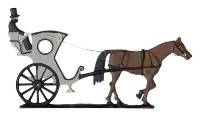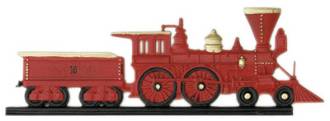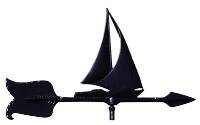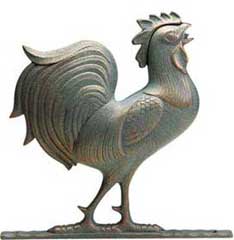|
Weathervanes - The Oldest Type of Home Weather StationDo I hear you asking just what are weathervanes doing on a website focused on home weather stations? Fair question, but a weathervane (or weather vane, or windvane, or wind vane) has every right to be here, because weathervanes are actually the oldest form of weather station. Weather has always been important to people, probably more so in the past when weather conditions were critical to farming, as they still are, and wind powered water transportusing various forms of sailing boats. But it is only recently that barometers have become common enough, and communications fast enough, to allow more accurate means of weather forecasting. In the past, weather changes were predicted by observing the clouds and the wind direction, particularly when it changed. Now it's easy enough to find the general direction of the wind by watching the way the trees bend, or smoke moves, or flags fly, or even by holding a wet finger aloft. But some of these methods are not very accurate, and don't work well in light winds or sheltered areas. So an elevated, easily visible structure showing the wind direction was a pretty useful tool. Weathervanes Combine Beauty and Usefulness With a Long and Distinguished History of Weather ForecastingThe first recorded weathervane was constructed in Athens in 48 BC, appropriately on the Tower of the Winds. They have been in widespread use ever since, including by the early Vikings.
That was a long time ago, but the tradition has continued, and been added to. One variation was the use of coats of arms or trademarks - somewhat like a flag converted to a weather vane, and called a banneret. How Weathervanes Are MadeAlthough the weather cock has persisted, and is still very popular, in more recent times much more initiative, invention and design skills have crept in. For a weathervane is really very simple to design. To be successful it must be free swinging and accurately balanced, and one half must be smaller in area than the other. This allows the wind to push the vane around until the veather vane is parallel to the wind with the larger end downwind 
This means that on a conventional design, the point of the arrow points to where the wind is blowing from, which is the conventional way we use to describe wind - a southerly wind blows from the south, and that is where the arrow will point. So a conventional weathervane today will consist of a pole with a freely rotating vane fitted into or onto the pole above a fixed direction indicator. The vane must be installed at its point of balance, where the weight is equally distributed either side of the pole, and with less surface area in the design at the end that will point to where the wind is coming from. There may or may not be an arrow head at this end, although with some modern designs there certainly should be. It's easy to see that with such simple design rules many types of weathervane are possible. There are of course the traditional forms of the arrow on its own, the banneret or the cock. But after that anything goes, although there are three main design forms. The Silhouette - a single sheet of metal cut to represent almost anything - a bird, an animal, a scene, even a person. Swell-bodied - similar to the silhouette but moulded to give a three dimensional effect, but not as much as the... Full-bodied weathervane - basically a realistic sculpture, but still conforming to the rule of equal mass either side of the pivot point, but unequal design area.
Weathervanes can be installed on your roof, or on a pole in your yard or garden. They can be made of any material, although it's hard to beat some form of meatal for durability and stability, and copper or bronze are popular. They are fairly to easy to find in hardware stores, garden centers and sometimes furniture decor stores. They are also the foundation for many small home businesses, many of whom will make a weathervane to your own design. .

But for convenience and range of design it's hard to beat the internet, and prices there are also very competitive. So if you can see a place for a weathervane in your life and garden - and they do provide an easy way of finding the wind direction when you are outside - it's definitely worth checking the fascinating designs at Outdoor Living – by Yardiac And for the very diverse Whitehall range of weathervanes, try KnobsandThings.com I think you'll find the prices are also attractive
This link will take you back to the Top, or, when you're ready, here's how to return to the Home page. You may be interested to know that you can find out more about weather and home weather stations by receiving our newsletter ,"Watching Weather". It's published more or less weekly, and apart from tips on how to use your weather station and understand what it's telling you about the weather around you, it also covers many other weather related topics. If this sounds interesting, just add your name and email address to the form below. When you join, you'll also receive, totally free, a 20 page guide to setting up and trouble shooting problems in home weather stations. And I promise that you won't get spammed, and that your sign up details will remain totally confidential. Sign up now and receive your first issue almost immediately.
Last update 05/28/2011
|






